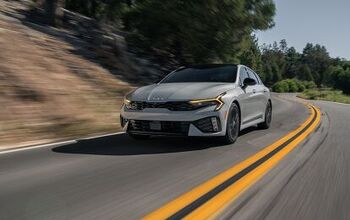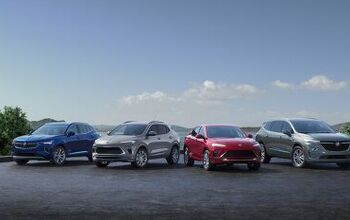Curbside Classic: Sunbeam Tiger – The Other Cobra

The legend of how Carroll Shelby was inspired by Ford’s very compact new V8 to create the Cobra by stuffing it into an elderly and underpowered little British roadster is well known. The fact that it had a copycat is not quite so legendary. That probably has everything to do with the choice of the car to be the beneficiary of the Ford V8 engine transplant:
The AC Ace had a tube frame chassis with four wheel-independent suspension and a racy Italianesque aluminum body draping it. That’s what inspired Shelby to inquire about a V8 version. The Sunbeam Alpine? It was Rootes’ attempt to compete with the MGA and MGB, and was even more pedestrian than the Austin-based MGs in its origins. It sat on a modified Hillman Husky station wagon platform and was blessed with all the finest kit stolen from the Rootes parts bin: a 1600 cc pushrod four with 80 hp, a live rear axle, and a body that was an obvious rip-off of the ’55-’57 Thunderbird, but with exaggerated fins, as seen here in this version driven by Sean Connery in one of the early James Bond movies. That wasn’t an accident; Rootes designer Ken Howe worked at Ford previously.
As so many sports cars of that era, the Alpine’s primary target was the US, where it was hoped that 80% of the production would be sold. Like the T-Bird it imitated, the Alpine’s lack of power and hardly stellar steering and handling resigned it more to the role of a tourer than a genuine sports car. Having seen what the little Ford V8 did to the Ace, Rootes’ US West Coast Sales Manager Ian Garrad contracted with Shelby to stuff the 164 hp 260 cid engine into the Alpine. In his usual rapacious way, Shelby agreed, for $10k ($70k adjusted). The result was deemed good. But just for good measure, Ken Miles was asked to build a second prototype at his shop, which he did in a few days and for a bill of $600.
The newly and duly-named Tiger was greenlighted, and Rootes gave the production job to Jensen, who built about 7,000 of the little bombs. Fortunately, by the time the Tiger got rolling, Rootes modified the pointy fins to bring them closer to earth. Production started in 1964, and was ended prematurely in 1967 when Chrysler (ever so wisely) bought Rootes, and pulled the plug on selling a Ford-engined car. Chrysler’s 273 cid LA engine wasn’t nearly as compact as the Ford, and had its distributor in the rear. The Tiger’s short prowl was over.
This particular example, which is being groomed for sale, has a 271 hp HiPo 289 that its previous owner inserted in place of the two-barrel 260. But I’ve been told that utilizing the full power of the 289 is dangerous in more ways than one, including damaging the spring shackle mountings and other aspects of the car’s undercarriage that started life as a 50hp Hillman wagon. The original 260 goes along with the sale, and may well be put back for authenticity’s sake and the fact that 164 hp is about as much as the Tiger can handle.
Keep in mind that the AC Ace needed some modifications to its front and rear ends in its 289 incarnation, and was completely redesigned (with major help from Ford) with a totally new frame and suspension to handle the 427 and 428 engines (yes, contrary to myth, many of the “427” Cobras were actually built with the 428 FE engine).
The Tiger has an undeniable charm, and a lovely exhaust burble. But it never quite escaped its origins, and always had a bit of a mixed image: was it a poor man’s Cobra or a shrunken T-Bird? The fact that Maxwell Smart drove one didn’t exactly help either.

More by Paul Niedermeyer
Latest Car Reviews
Read moreLatest Product Reviews
Read moreRecent Comments
- Kwik_Shift_Pro4X I fell asleep looking at that image.
- Verbal Rented a Malibu a while back. It was fine, if a bit gutless.I get that Detroit wants to go all-in on high profit margin SUVs and blinged-out MAGA trucks. Everyone has known for decades that they can't compete on price in the affordable sedan space. So now all of Detroit's sedans are gone except for a couple of Cadillac models.But you'd think that just one of the domestic brands could produce a fun, competitive and affordable sedan. Just one? Please? Anyone? Bueller?
- 3-On-The-Tree I wouldn’t even use Ford as a hearse for fear of being late to my party.
- SCE to AUX Norway is in Europe, and Tesla is an American automaker - no problems there.I wouldn't use Ford as the bellwether.https://www.reuters.com/business/autos-transportation/tesla-extends-lead-norway-evs-take-record-82-market-share-2024-01-02/https://elbil.no/english/norwegian-ev-policy/
- Steve Biro If the U.S. government wants to talk about banning all connected cars - or at least the collection and sharing of information from said vehicles - I’m all ears. Otherwise, don’t waste my time.







































Comments
Join the conversation
The Sunbeam Alpine was on my list when I was shopping for a used convertible years ago. I ended up with a Fiat Spider. I did drive a Sunbeam and it was downright scary. The handling was horrendous and the brakes totally inadequate.
I traded a well used Alpine for a new '65 Tiger in '66. The Tiger was black and stock except for the mag wheels with the Tiger logo spinners on them (real magnesium alloy). Wow was it a blast to drive. City driving was: Start rolling in 1st and then shift to 4th and drive away. That 260 had a lot of torque. I only lost 2 street drags with it, one to a big block corvette and the other to blown GTO. Still got 22+ mpg combined driving. Top end was somewhere over 117, I never found enough good road in the mid Ohio area to let it wind all the way out. I did get airborne a few time on paved back country roads, the Mustang GT who was trying to keep up had to back off after bottoming out twice, no problem for the Tiger. I do remember very hot foot wells on long summer trips. There was a trick to help cooling, you installed small blocks of wood under the bonnet latch and stops to raise the back of the bonnet and let the heat out of the engine compartment. Handling was very good for the era, just don't drive hard into a corner with any kind of loose material on the road surface, don't ask me how I know. And above all, don't dump the clutch with the engine torqued up if you want to keep the rear end. Had to get rid of the car after a couple of years due to family size increase and did not have the dinero to run 2 cars. Probably a good thing come to think of it, I probably would have kept up with the wild driving until something nasty happened. This Tiger was my favorite out of all the cars/trucks/SUVs that I have owned over the years.